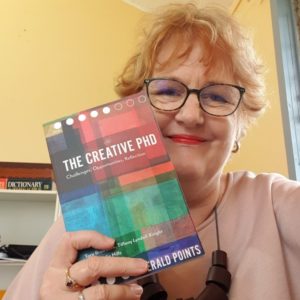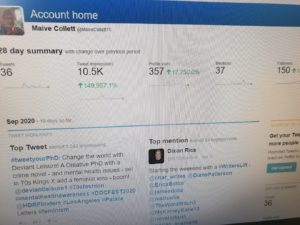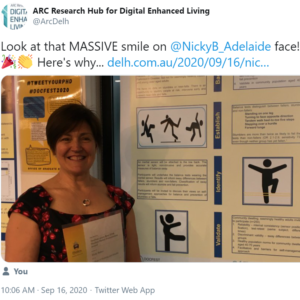Flinders University DocFest 2020 week was terrific – so many activities, so much on offer! Students could pick and choose what and how to participate.
Two HDR students – very different research, diverse approaches, distinct writing styles – each had great success from #TweetyourPhD.

@MaiveCollett11
#tweetyourPhD: Change the world with Deviant Leisure! A Creative PhD with a crime novel – and mental health issues – set in 70s Kings X add a feminist lens – boom! @deviantleisure1 #70sfashion #mentalhealthawareness #DOCFEST2020 @HDRFlinders #LosAngeles #palaceletters #feminism
Excited about #DocFest2020, I attended ‘The Creative PhD’ book launch on Tuesday via livestream and asked a question through sli.do. That won me a copy of the book by Tara Brabazon, Tiffany Lyndall-Knight and Natalie Hills (Emerald, 2020). Earlier in the year, I had enrolled for the Three Minute Thesis (3MT) with Tiffany Lyndall-Knight. In the 3MT practice sessions, you need to have a tight configuration of your PhD before you can practice your pitch. The questions asked by Tiffany during the practice were provoking, but helped me to distil my PhD. The 3MT is one of the professional development options offered across the year. As with #DocFest2020, the event is entirely optional. It is easy to think that one is too busy. The PhD can be like a pressure cooker – where is the release valve? Maybe it is in these optional events?
I was like many of us in the PhD program, working hard attempting to achieve my goals. As I approach the end of the year, I am asking myself ‘Have I met the goals I set? What can I do to up my game?’ I looked at the possibilities for DocFest2020 and saw #tweetyourPhD. I have hand injuries and no experience with posters so I chose the #tweet. I had made one tweet in my whole life. I am a mature student – could I pull it off? Also, I had few followers – my supervisor (who is kind) and a couple of people she followed, who had graciously followed me back.
On 4th September, I attended The Write Bunch – a weekly meeting for distance PhD students where we silently write for 30 mins then have a fast debrief about what we are writing this week. I live interstate so The Write Bunch is my lifeline. Here are my 3 hours.
Knowing less than nothing about tweets except that the big orange uses it to reinforce binary opinions in the US of A, I jumped in. Okay here goes. I Googled – the database of the stars – how do I write a tweet. I only had time to read one of the ten options that came up. I made a choice. That was it – it told me that a successful tweet incorporated #hashtags. Okay. I started to think #’s.
I am doing an irregular mode of research – a Creative PhD. The Creative PhD has an exegesis and artefact. The artefact is created and interplays with a process of reflection both on and with the exegesis. For me the reflection is hugely important. I write a crime novel as my artefact. I use a theoretical palette which is complex – called Deviant Leisure – over which I superimpose a feminist frame. Then I mix in mental health issues. Then twist the whole thing to make a lens on the seventies. I can hear the resemblance to an exotic martini. (Overall, I practice sobriety so that is not going to happen!)
So, there were plenty of ‘isms for me to hashtag. Google Docs offer a character count so I played around with my tweet. Still where to start? I checked out the top scholars in my field. One of them doesn’t tweet at all and the other has a hashtag. I decided – I knew it was a bit cheeky – to use that hashtag, in amongst the others. There is a mirror to my writing on 70’s Kings Cross to the 70’s in Los Angeles, so I decided to throw that in too. My other hashtags – #70’s fashion, #palaceletters – relate to the content of the novel. Mental health issues are a major theme of my academic and creative writing hence #mentalhealthawareness.
I set my tweet free! It instantly had a life of its own! A Los Angeles radio station liked and retweeted me. Later in the day someone in my field followed me – they need to remain nameless; I know you’ll understand. The penny dropped and I decided to work it. I followed people who followed me. I followed people who related to my theoretical streams. I noticed a tacit agreement in Twitter – you follow me, I follow you. I also asked my friends on Facebook to retweet me. I asked groups I was in if I retweeted them would they retweet me? They did. Some did. That was enough to begin momentum.

Then excitement of all excitement I found a thing called #writerslift and #writerscommunity. Tweeters make a call for a #writerslift and then everyone – some people – post their tweet and then everyone – some people, I am prone to exaggeration – follow each other in this process. I participated in this process as often as my hands would allow – they ache if I do not protect them. I gained 50 in the first week of tweeting and now have 150 followers.
All because of the #tweetyourphd competition. Count me in for next time! No wonder the orange guy does this. It is addictive! The internationality of Twitter far outweighs what I have achieved networking through Facebook or any other method. Hooked!

@NickyB_Adelaide #TweetyourPhD Why do some people stumble and rebalance but others stumble and fall? Stumbles are more common and pre-empt falls. Why wait to treat falls when we could prevent stumbles? Investigating stumbles to prevent falls with digital health @HDRFlinders #Docfest2020 @ArcDelh
Conveying the importance and relevance of your research in short, sharp messages is essential. But…how do you condense your research into a poster? How do you talk about the importance, relevance, impact and novelty of your research in two minutes or less? How do you choose the essential 280 characters or less in a #tweet? #DocFest2020 provided a safe learning environment to trial these new ways of communicating. The poster pitch was a two-minute talk about our research, similar in style to the three-minute thesis (3MT). Learning how to compress the problem being investigated, the research contribution, its novelty, and its application to the broader community into a two-minute talk was huge fun! The practice session provided feedback – keep it punchy, make it pop! I was learning how to keep the research message shorter.
Similar to Maive, I had a Twitter account, followed eight or so people (mainly linked with my hobby of cycling), and had one follower myself. I had never written a Tweet. I saw Maive’s comment on #TweetyourPhD in the Write Bunch conversation and thought, maybe I could give it a go myself? This nudge was all it took. My tweet was picked up by fellow students, colleagues in the university community and by the industry sponsor of my PhD, the Digital Enhanced Living Hub (DELH). Later that week I joined the other students to present my two-minute poster pitch, with gentle questioning from the HDR college reps (shout out to Reem and Jen!). I was lucky enough to win the College of Nursing and Health Sciences poster pitch competition. Fantastic! I received a certificate and prize, so took a photo of the win. Better tweet that too!
Adding the photo of the poster pitch to the #TweetyourPhD meant the information was shared broadly again. Twitter loves photos! The DELH then retweeted the poster pitch photo and wrote their own newsletter piece about the win. This newsletter is shared with the Hub’s digital health community, with disciplines other than my own, beyond my physiotherapy profession. So, my research is being talked about much more broadly and diversely than I ever anticipated or imagined, all thanks to #DocFest! As for Twitter, I follow DELH followers, and some of them follow me back. This is such an opportunity, not only for disseminating my research, but for potential employment at the end of the PhD! What a difference a tweet makes!

